Managing a Successful Business Project: Verdant Leisure Case Study
VerifiedAdded on 2023/01/10
|29
|5630
|91
Report
AI Summary
This report is a comprehensive analysis of a business project focused on identifying and addressing issues of gender and racial inequality and diversity within Verdant Leisure, a holiday park company. The project includes a detailed project management plan, outlining aims, objectives, scope, timescales, costs, quality management, communication, and risk assessment. A work breakdown structure and Gantt chart are provided to illustrate project timelines and activities. The report employs qualitative research methods, including questionnaires, to gather data from employees, and utilizes thematic data analysis to analyze the findings. The findings reveal insights into employee perceptions of diversity, equality of opportunity, and experiences of discrimination. Based on the analysis, the report offers recommendations for improving equality and diversity within Verdant Leisure, covering aspects such as employee motivation, work behavior, and organizational performance. A reflection on the project's success and the author's own performance is included, along with supporting references.
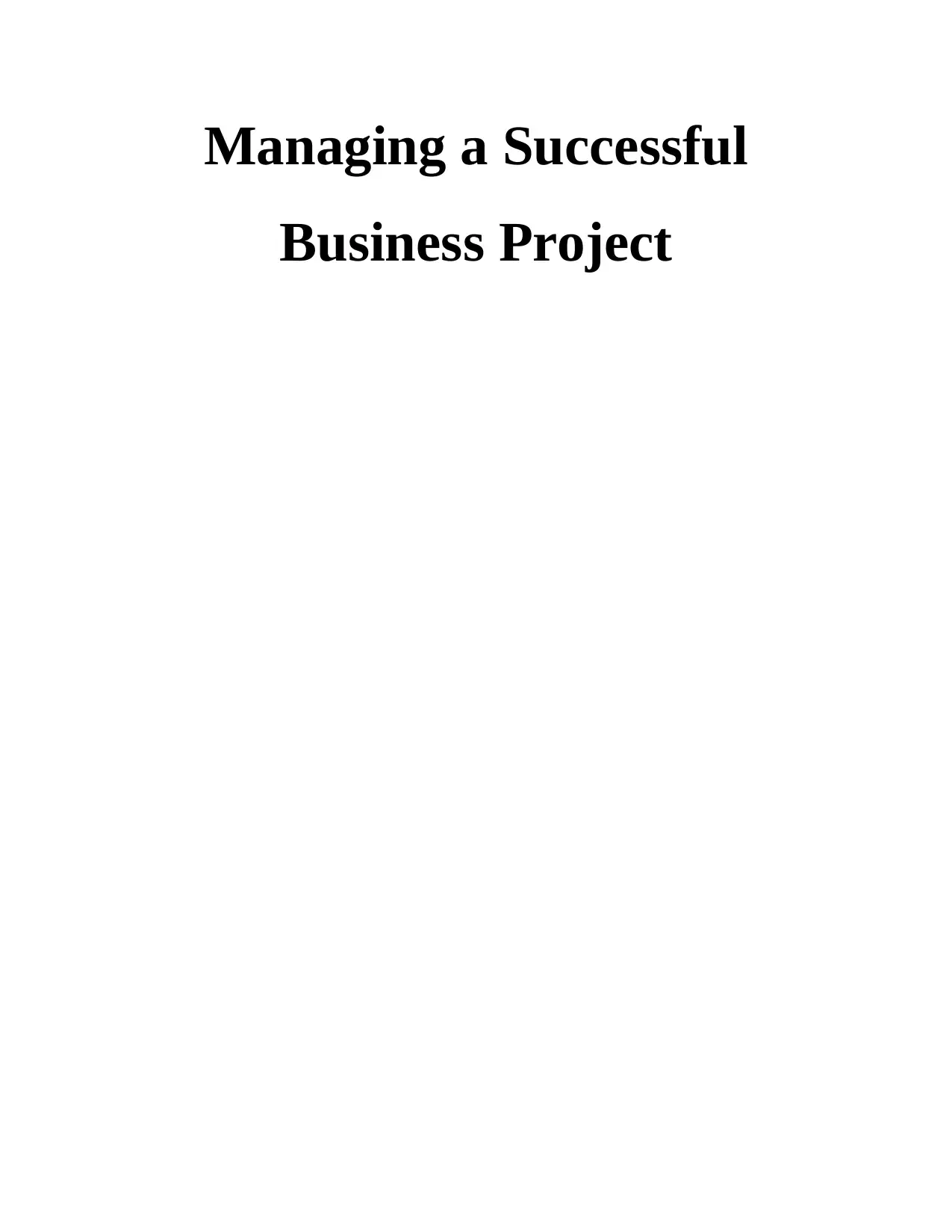
Managing a Successful
Business Project
Business Project
Paraphrase This Document
Need a fresh take? Get an instant paraphrase of this document with our AI Paraphraser
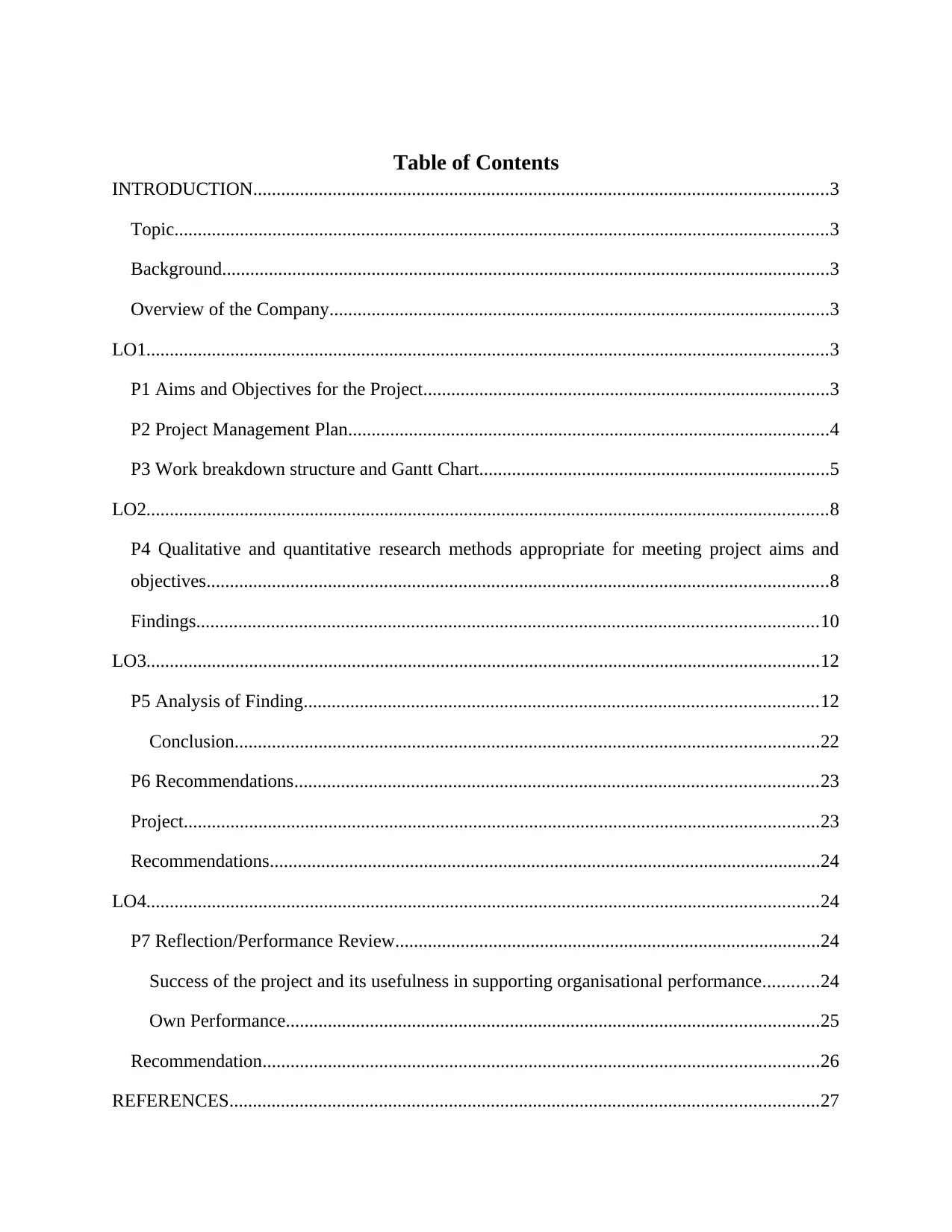
Table of Contents
INTRODUCTION...........................................................................................................................3
Topic............................................................................................................................................3
Background..................................................................................................................................3
Overview of the Company...........................................................................................................3
LO1..................................................................................................................................................3
P1 Aims and Objectives for the Project.......................................................................................3
P2 Project Management Plan.......................................................................................................4
P3 Work breakdown structure and Gantt Chart...........................................................................5
LO2..................................................................................................................................................8
P4 Qualitative and quantitative research methods appropriate for meeting project aims and
objectives.....................................................................................................................................8
Findings.....................................................................................................................................10
LO3................................................................................................................................................12
P5 Analysis of Finding..............................................................................................................12
Conclusion.............................................................................................................................22
P6 Recommendations................................................................................................................23
Project........................................................................................................................................23
Recommendations......................................................................................................................24
LO4................................................................................................................................................24
P7 Reflection/Performance Review...........................................................................................24
Success of the project and its usefulness in supporting organisational performance............24
Own Performance..................................................................................................................25
Recommendation.......................................................................................................................26
REFERENCES..............................................................................................................................27
INTRODUCTION...........................................................................................................................3
Topic............................................................................................................................................3
Background..................................................................................................................................3
Overview of the Company...........................................................................................................3
LO1..................................................................................................................................................3
P1 Aims and Objectives for the Project.......................................................................................3
P2 Project Management Plan.......................................................................................................4
P3 Work breakdown structure and Gantt Chart...........................................................................5
LO2..................................................................................................................................................8
P4 Qualitative and quantitative research methods appropriate for meeting project aims and
objectives.....................................................................................................................................8
Findings.....................................................................................................................................10
LO3................................................................................................................................................12
P5 Analysis of Finding..............................................................................................................12
Conclusion.............................................................................................................................22
P6 Recommendations................................................................................................................23
Project........................................................................................................................................23
Recommendations......................................................................................................................24
LO4................................................................................................................................................24
P7 Reflection/Performance Review...........................................................................................24
Success of the project and its usefulness in supporting organisational performance............24
Own Performance..................................................................................................................25
Recommendation.......................................................................................................................26
REFERENCES..............................................................................................................................27

⊘ This is a preview!⊘
Do you want full access?
Subscribe today to unlock all pages.

Trusted by 1+ million students worldwide
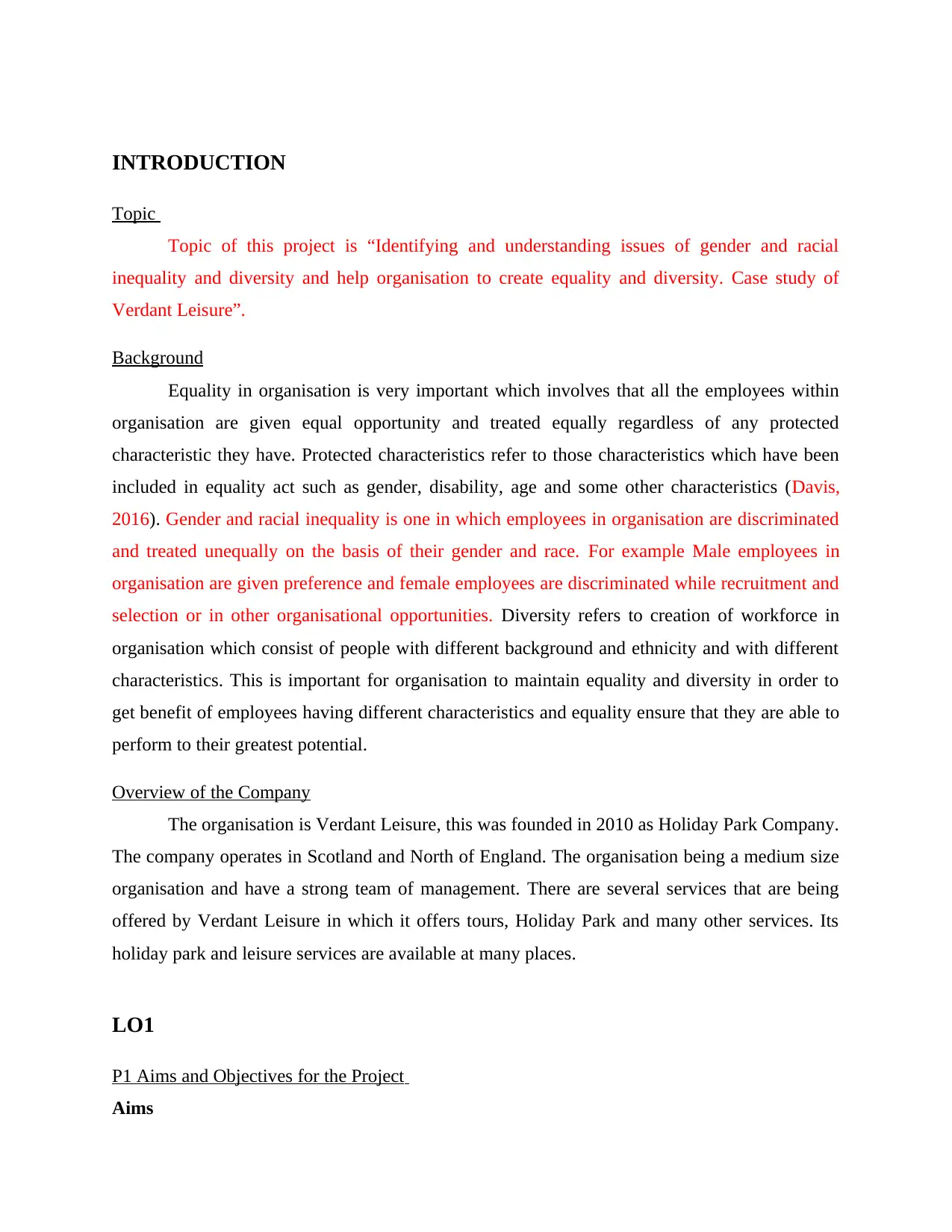
INTRODUCTION
Topic
Topic of this project is “Identifying and understanding issues of gender and racial
inequality and diversity and help organisation to create equality and diversity. Case study of
Verdant Leisure”.
Background
Equality in organisation is very important which involves that all the employees within
organisation are given equal opportunity and treated equally regardless of any protected
characteristic they have. Protected characteristics refer to those characteristics which have been
included in equality act such as gender, disability, age and some other characteristics (Davis,
2016). Gender and racial inequality is one in which employees in organisation are discriminated
and treated unequally on the basis of their gender and race. For example Male employees in
organisation are given preference and female employees are discriminated while recruitment and
selection or in other organisational opportunities. Diversity refers to creation of workforce in
organisation which consist of people with different background and ethnicity and with different
characteristics. This is important for organisation to maintain equality and diversity in order to
get benefit of employees having different characteristics and equality ensure that they are able to
perform to their greatest potential.
Overview of the Company
The organisation is Verdant Leisure, this was founded in 2010 as Holiday Park Company.
The company operates in Scotland and North of England. The organisation being a medium size
organisation and have a strong team of management. There are several services that are being
offered by Verdant Leisure in which it offers tours, Holiday Park and many other services. Its
holiday park and leisure services are available at many places.
LO1
P1 Aims and Objectives for the Project
Aims
Topic
Topic of this project is “Identifying and understanding issues of gender and racial
inequality and diversity and help organisation to create equality and diversity. Case study of
Verdant Leisure”.
Background
Equality in organisation is very important which involves that all the employees within
organisation are given equal opportunity and treated equally regardless of any protected
characteristic they have. Protected characteristics refer to those characteristics which have been
included in equality act such as gender, disability, age and some other characteristics (Davis,
2016). Gender and racial inequality is one in which employees in organisation are discriminated
and treated unequally on the basis of their gender and race. For example Male employees in
organisation are given preference and female employees are discriminated while recruitment and
selection or in other organisational opportunities. Diversity refers to creation of workforce in
organisation which consist of people with different background and ethnicity and with different
characteristics. This is important for organisation to maintain equality and diversity in order to
get benefit of employees having different characteristics and equality ensure that they are able to
perform to their greatest potential.
Overview of the Company
The organisation is Verdant Leisure, this was founded in 2010 as Holiday Park Company.
The company operates in Scotland and North of England. The organisation being a medium size
organisation and have a strong team of management. There are several services that are being
offered by Verdant Leisure in which it offers tours, Holiday Park and many other services. Its
holiday park and leisure services are available at many places.
LO1
P1 Aims and Objectives for the Project
Aims
Paraphrase This Document
Need a fresh take? Get an instant paraphrase of this document with our AI Paraphraser
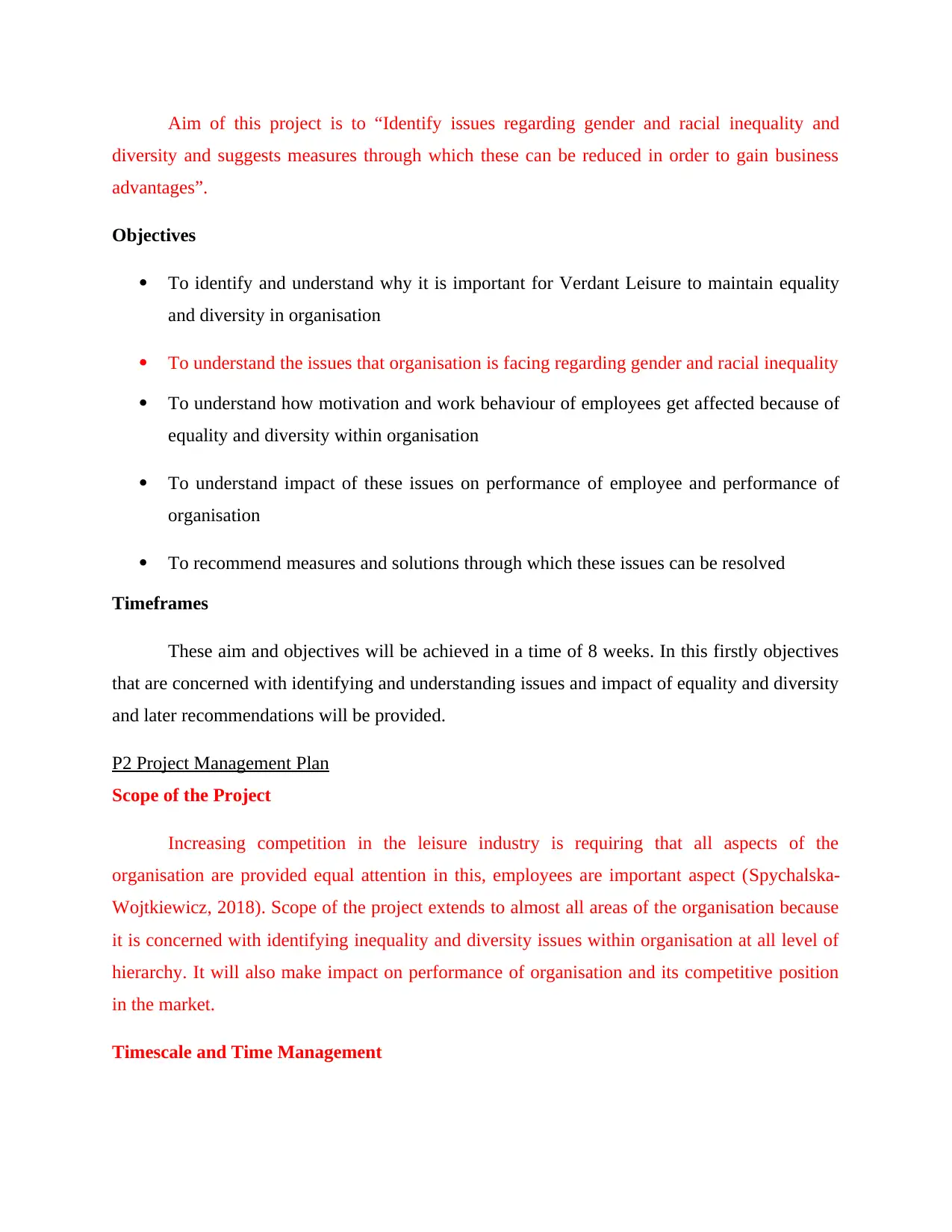
Aim of this project is to “Identify issues regarding gender and racial inequality and
diversity and suggests measures through which these can be reduced in order to gain business
advantages”.
Objectives
To identify and understand why it is important for Verdant Leisure to maintain equality
and diversity in organisation
To understand the issues that organisation is facing regarding gender and racial inequality
To understand how motivation and work behaviour of employees get affected because of
equality and diversity within organisation
To understand impact of these issues on performance of employee and performance of
organisation
To recommend measures and solutions through which these issues can be resolved
Timeframes
These aim and objectives will be achieved in a time of 8 weeks. In this firstly objectives
that are concerned with identifying and understanding issues and impact of equality and diversity
and later recommendations will be provided.
P2 Project Management Plan
Scope of the Project
Increasing competition in the leisure industry is requiring that all aspects of the
organisation are provided equal attention in this, employees are important aspect (Spychalska-
Wojtkiewicz, 2018). Scope of the project extends to almost all areas of the organisation because
it is concerned with identifying inequality and diversity issues within organisation at all level of
hierarchy. It will also make impact on performance of organisation and its competitive position
in the market.
Timescale and Time Management
diversity and suggests measures through which these can be reduced in order to gain business
advantages”.
Objectives
To identify and understand why it is important for Verdant Leisure to maintain equality
and diversity in organisation
To understand the issues that organisation is facing regarding gender and racial inequality
To understand how motivation and work behaviour of employees get affected because of
equality and diversity within organisation
To understand impact of these issues on performance of employee and performance of
organisation
To recommend measures and solutions through which these issues can be resolved
Timeframes
These aim and objectives will be achieved in a time of 8 weeks. In this firstly objectives
that are concerned with identifying and understanding issues and impact of equality and diversity
and later recommendations will be provided.
P2 Project Management Plan
Scope of the Project
Increasing competition in the leisure industry is requiring that all aspects of the
organisation are provided equal attention in this, employees are important aspect (Spychalska-
Wojtkiewicz, 2018). Scope of the project extends to almost all areas of the organisation because
it is concerned with identifying inequality and diversity issues within organisation at all level of
hierarchy. It will also make impact on performance of organisation and its competitive position
in the market.
Timescale and Time Management
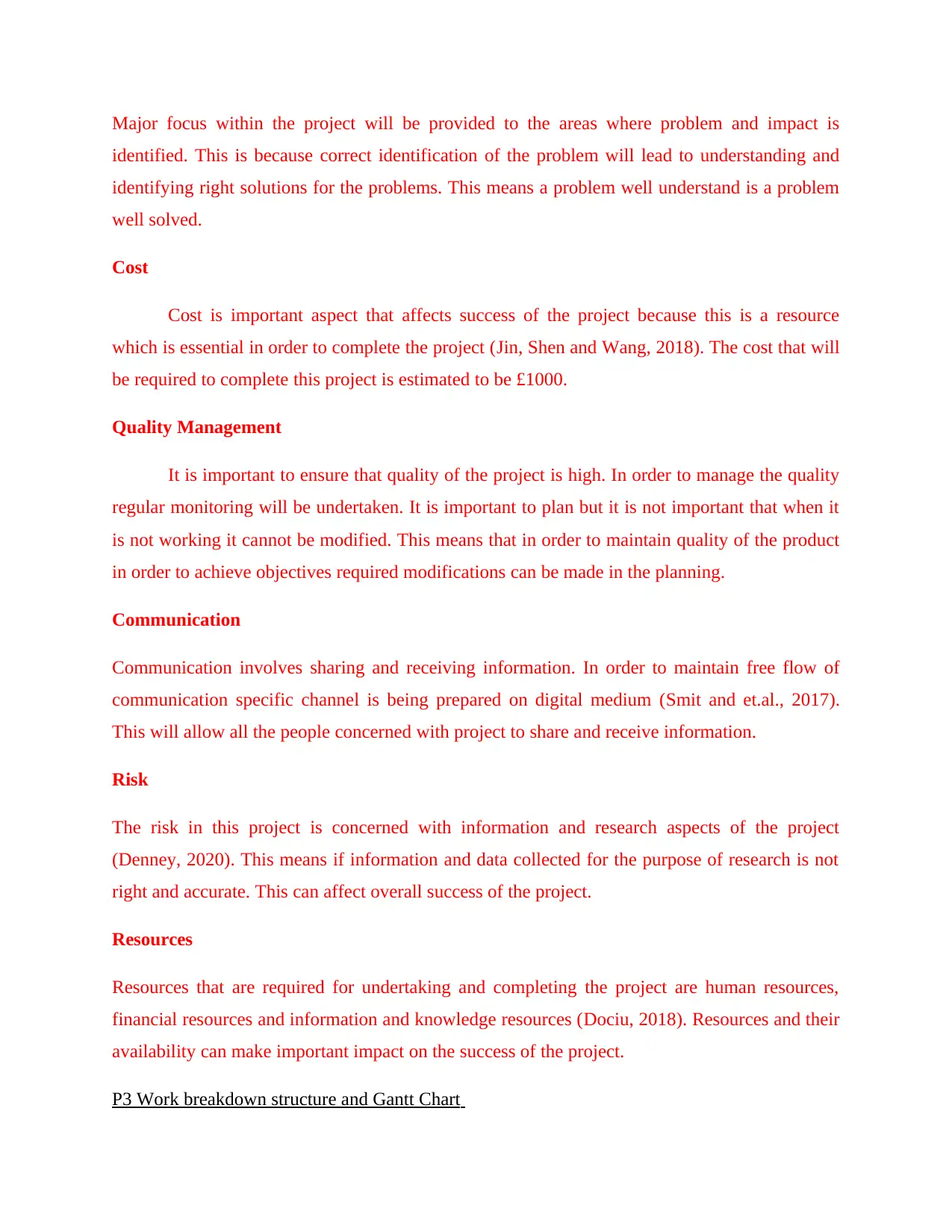
Major focus within the project will be provided to the areas where problem and impact is
identified. This is because correct identification of the problem will lead to understanding and
identifying right solutions for the problems. This means a problem well understand is a problem
well solved.
Cost
Cost is important aspect that affects success of the project because this is a resource
which is essential in order to complete the project (Jin, Shen and Wang, 2018). The cost that will
be required to complete this project is estimated to be £1000.
Quality Management
It is important to ensure that quality of the project is high. In order to manage the quality
regular monitoring will be undertaken. It is important to plan but it is not important that when it
is not working it cannot be modified. This means that in order to maintain quality of the product
in order to achieve objectives required modifications can be made in the planning.
Communication
Communication involves sharing and receiving information. In order to maintain free flow of
communication specific channel is being prepared on digital medium (Smit and et.al., 2017).
This will allow all the people concerned with project to share and receive information.
Risk
The risk in this project is concerned with information and research aspects of the project
(Denney, 2020). This means if information and data collected for the purpose of research is not
right and accurate. This can affect overall success of the project.
Resources
Resources that are required for undertaking and completing the project are human resources,
financial resources and information and knowledge resources (Dociu, 2018). Resources and their
availability can make important impact on the success of the project.
P3 Work breakdown structure and Gantt Chart
identified. This is because correct identification of the problem will lead to understanding and
identifying right solutions for the problems. This means a problem well understand is a problem
well solved.
Cost
Cost is important aspect that affects success of the project because this is a resource
which is essential in order to complete the project (Jin, Shen and Wang, 2018). The cost that will
be required to complete this project is estimated to be £1000.
Quality Management
It is important to ensure that quality of the project is high. In order to manage the quality
regular monitoring will be undertaken. It is important to plan but it is not important that when it
is not working it cannot be modified. This means that in order to maintain quality of the product
in order to achieve objectives required modifications can be made in the planning.
Communication
Communication involves sharing and receiving information. In order to maintain free flow of
communication specific channel is being prepared on digital medium (Smit and et.al., 2017).
This will allow all the people concerned with project to share and receive information.
Risk
The risk in this project is concerned with information and research aspects of the project
(Denney, 2020). This means if information and data collected for the purpose of research is not
right and accurate. This can affect overall success of the project.
Resources
Resources that are required for undertaking and completing the project are human resources,
financial resources and information and knowledge resources (Dociu, 2018). Resources and their
availability can make important impact on the success of the project.
P3 Work breakdown structure and Gantt Chart
⊘ This is a preview!⊘
Do you want full access?
Subscribe today to unlock all pages.

Trusted by 1+ million students worldwide
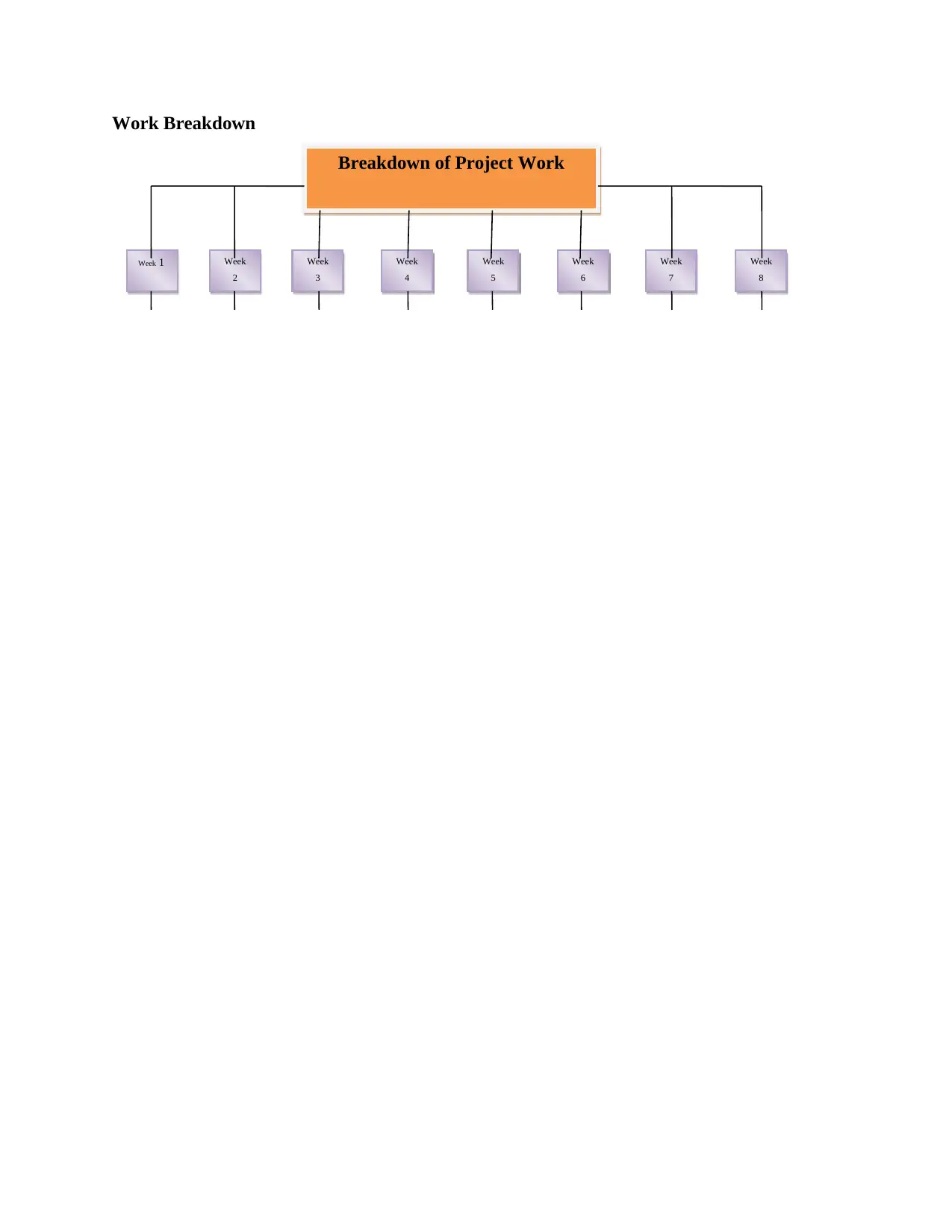
Work Breakdown
Week 1 Week
2
Week
3
Week
4
Week
5
Week
8
Week
7
Week
6
Breakdown of Project Work
Week 1 Week
2
Week
3
Week
4
Week
5
Week
8
Week
7
Week
6
Breakdown of Project Work
Paraphrase This Document
Need a fresh take? Get an instant paraphrase of this document with our AI Paraphraser
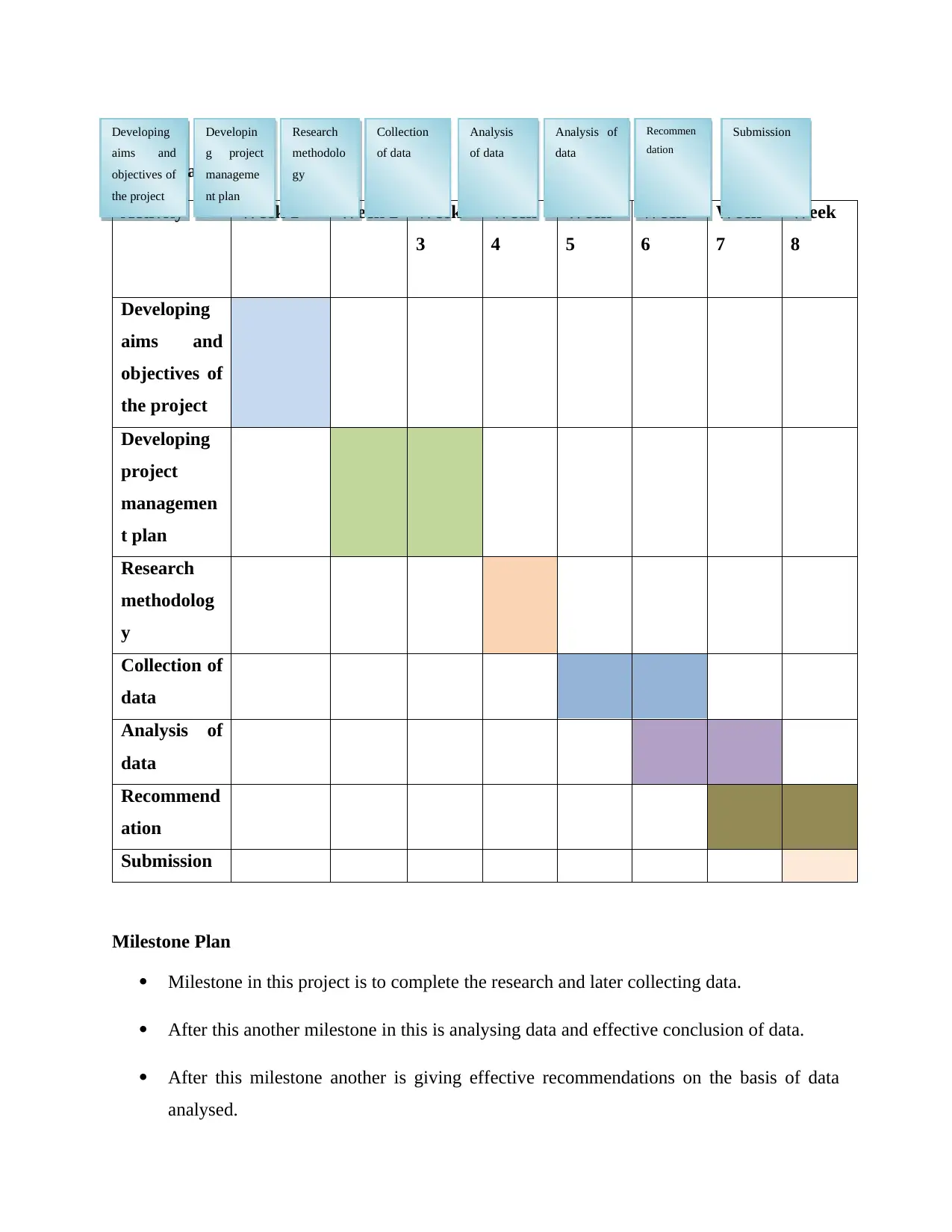
Gantt Chart
Activity Week 1 Week 2 Week
3
Week
4
Week
5
Week
6
Week
7
Week
8
Developing
aims and
objectives of
the project
Developing
project
managemen
t plan
Research
methodolog
y
Collection of
data
Analysis of
data
Recommend
ation
Submission
Milestone Plan
Milestone in this project is to complete the research and later collecting data.
After this another milestone in this is analysing data and effective conclusion of data.
After this milestone another is giving effective recommendations on the basis of data
analysed.
Developing
aims and
objectives of
the project
Developin
g project
manageme
nt plan
Research
methodolo
gy
Collection
of data
Analysis
of data
Analysis of
data
Recommen
dation
Submission
Activity Week 1 Week 2 Week
3
Week
4
Week
5
Week
6
Week
7
Week
8
Developing
aims and
objectives of
the project
Developing
project
managemen
t plan
Research
methodolog
y
Collection of
data
Analysis of
data
Recommend
ation
Submission
Milestone Plan
Milestone in this project is to complete the research and later collecting data.
After this another milestone in this is analysing data and effective conclusion of data.
After this milestone another is giving effective recommendations on the basis of data
analysed.
Developing
aims and
objectives of
the project
Developin
g project
manageme
nt plan
Research
methodolo
gy
Collection
of data
Analysis
of data
Analysis of
data
Recommen
dation
Submission
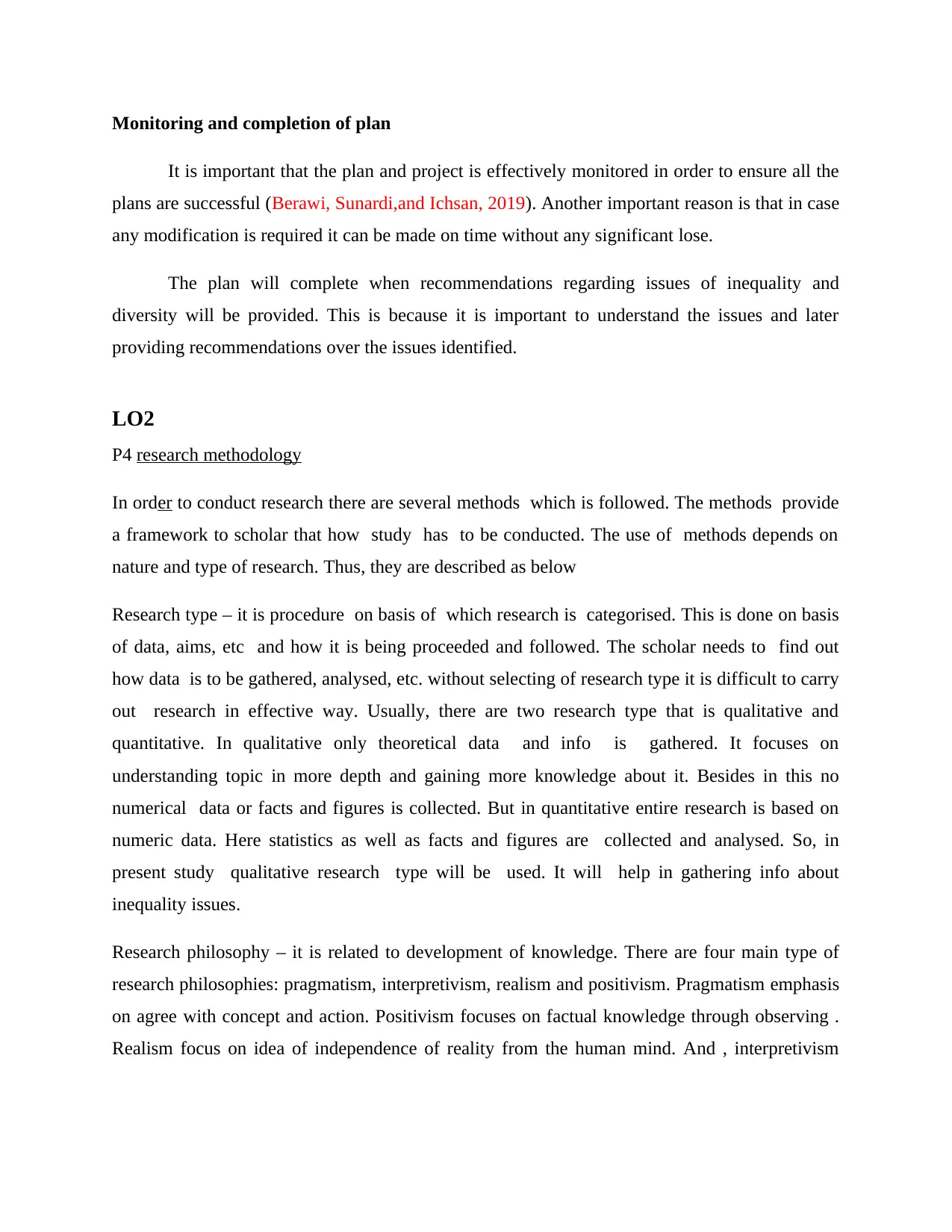
Monitoring and completion of plan
It is important that the plan and project is effectively monitored in order to ensure all the
plans are successful (Berawi, Sunardi,and Ichsan, 2019). Another important reason is that in case
any modification is required it can be made on time without any significant lose.
The plan will complete when recommendations regarding issues of inequality and
diversity will be provided. This is because it is important to understand the issues and later
providing recommendations over the issues identified.
LO2
P4 research methodology
In order to conduct research there are several methods which is followed. The methods provide
a framework to scholar that how study has to be conducted. The use of methods depends on
nature and type of research. Thus, they are described as below
Research type – it is procedure on basis of which research is categorised. This is done on basis
of data, aims, etc and how it is being proceeded and followed. The scholar needs to find out
how data is to be gathered, analysed, etc. without selecting of research type it is difficult to carry
out research in effective way. Usually, there are two research type that is qualitative and
quantitative. In qualitative only theoretical data and info is gathered. It focuses on
understanding topic in more depth and gaining more knowledge about it. Besides in this no
numerical data or facts and figures is collected. But in quantitative entire research is based on
numeric data. Here statistics as well as facts and figures are collected and analysed. So, in
present study qualitative research type will be used. It will help in gathering info about
inequality issues.
Research philosophy – it is related to development of knowledge. There are four main type of
research philosophies: pragmatism, interpretivism, realism and positivism. Pragmatism emphasis
on agree with concept and action. Positivism focuses on factual knowledge through observing .
Realism focus on idea of independence of reality from the human mind. And , interpretivism
It is important that the plan and project is effectively monitored in order to ensure all the
plans are successful (Berawi, Sunardi,and Ichsan, 2019). Another important reason is that in case
any modification is required it can be made on time without any significant lose.
The plan will complete when recommendations regarding issues of inequality and
diversity will be provided. This is because it is important to understand the issues and later
providing recommendations over the issues identified.
LO2
P4 research methodology
In order to conduct research there are several methods which is followed. The methods provide
a framework to scholar that how study has to be conducted. The use of methods depends on
nature and type of research. Thus, they are described as below
Research type – it is procedure on basis of which research is categorised. This is done on basis
of data, aims, etc and how it is being proceeded and followed. The scholar needs to find out
how data is to be gathered, analysed, etc. without selecting of research type it is difficult to carry
out research in effective way. Usually, there are two research type that is qualitative and
quantitative. In qualitative only theoretical data and info is gathered. It focuses on
understanding topic in more depth and gaining more knowledge about it. Besides in this no
numerical data or facts and figures is collected. But in quantitative entire research is based on
numeric data. Here statistics as well as facts and figures are collected and analysed. So, in
present study qualitative research type will be used. It will help in gathering info about
inequality issues.
Research philosophy – it is related to development of knowledge. There are four main type of
research philosophies: pragmatism, interpretivism, realism and positivism. Pragmatism emphasis
on agree with concept and action. Positivism focuses on factual knowledge through observing .
Realism focus on idea of independence of reality from the human mind. And , interpretivism
⊘ This is a preview!⊘
Do you want full access?
Subscribe today to unlock all pages.

Trusted by 1+ million students worldwide
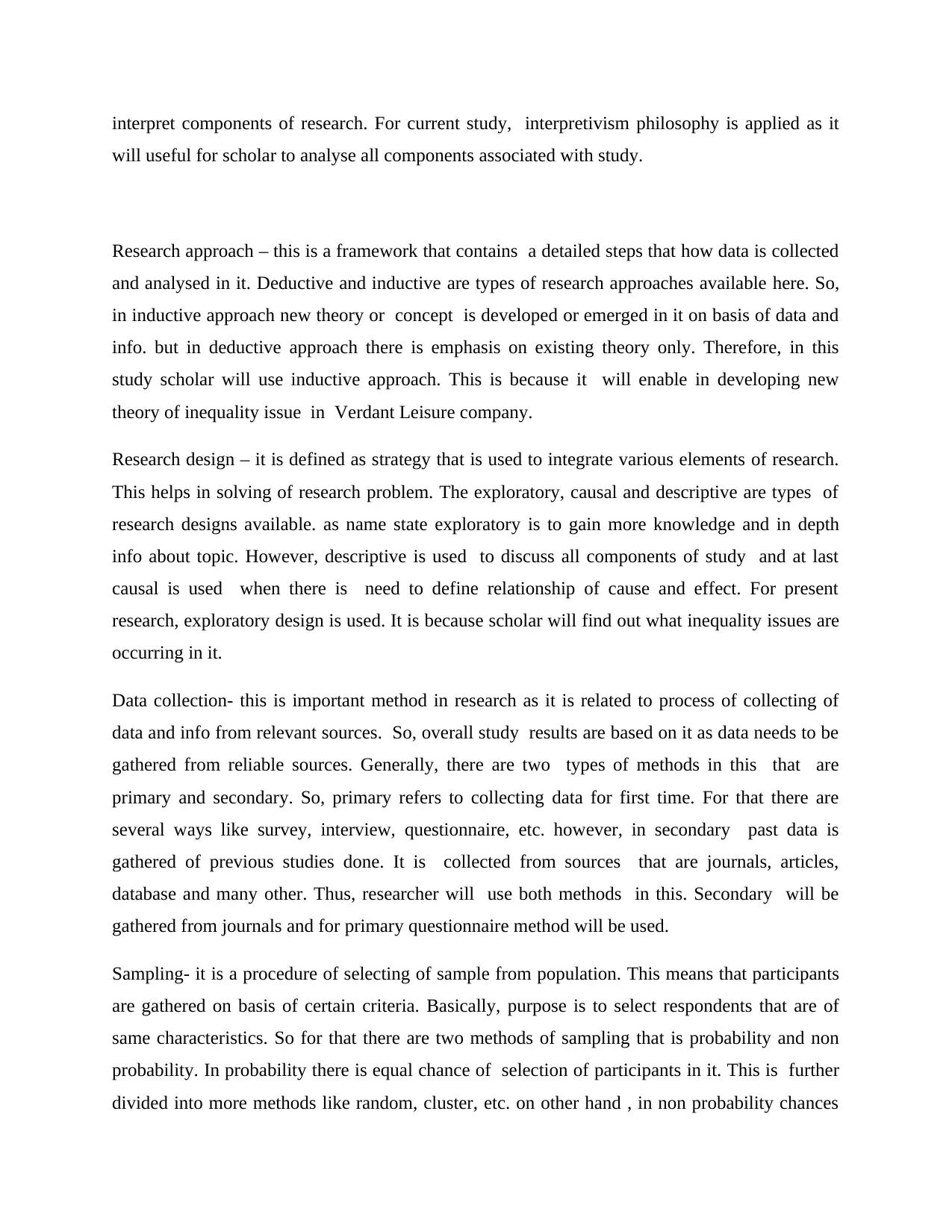
interpret components of research. For current study, interpretivism philosophy is applied as it
will useful for scholar to analyse all components associated with study.
Research approach – this is a framework that contains a detailed steps that how data is collected
and analysed in it. Deductive and inductive are types of research approaches available here. So,
in inductive approach new theory or concept is developed or emerged in it on basis of data and
info. but in deductive approach there is emphasis on existing theory only. Therefore, in this
study scholar will use inductive approach. This is because it will enable in developing new
theory of inequality issue in Verdant Leisure company.
Research design – it is defined as strategy that is used to integrate various elements of research.
This helps in solving of research problem. The exploratory, causal and descriptive are types of
research designs available. as name state exploratory is to gain more knowledge and in depth
info about topic. However, descriptive is used to discuss all components of study and at last
causal is used when there is need to define relationship of cause and effect. For present
research, exploratory design is used. It is because scholar will find out what inequality issues are
occurring in it.
Data collection- this is important method in research as it is related to process of collecting of
data and info from relevant sources. So, overall study results are based on it as data needs to be
gathered from reliable sources. Generally, there are two types of methods in this that are
primary and secondary. So, primary refers to collecting data for first time. For that there are
several ways like survey, interview, questionnaire, etc. however, in secondary past data is
gathered of previous studies done. It is collected from sources that are journals, articles,
database and many other. Thus, researcher will use both methods in this. Secondary will be
gathered from journals and for primary questionnaire method will be used.
Sampling- it is a procedure of selecting of sample from population. This means that participants
are gathered on basis of certain criteria. Basically, purpose is to select respondents that are of
same characteristics. So for that there are two methods of sampling that is probability and non
probability. In probability there is equal chance of selection of participants in it. This is further
divided into more methods like random, cluster, etc. on other hand , in non probability chances
will useful for scholar to analyse all components associated with study.
Research approach – this is a framework that contains a detailed steps that how data is collected
and analysed in it. Deductive and inductive are types of research approaches available here. So,
in inductive approach new theory or concept is developed or emerged in it on basis of data and
info. but in deductive approach there is emphasis on existing theory only. Therefore, in this
study scholar will use inductive approach. This is because it will enable in developing new
theory of inequality issue in Verdant Leisure company.
Research design – it is defined as strategy that is used to integrate various elements of research.
This helps in solving of research problem. The exploratory, causal and descriptive are types of
research designs available. as name state exploratory is to gain more knowledge and in depth
info about topic. However, descriptive is used to discuss all components of study and at last
causal is used when there is need to define relationship of cause and effect. For present
research, exploratory design is used. It is because scholar will find out what inequality issues are
occurring in it.
Data collection- this is important method in research as it is related to process of collecting of
data and info from relevant sources. So, overall study results are based on it as data needs to be
gathered from reliable sources. Generally, there are two types of methods in this that are
primary and secondary. So, primary refers to collecting data for first time. For that there are
several ways like survey, interview, questionnaire, etc. however, in secondary past data is
gathered of previous studies done. It is collected from sources that are journals, articles,
database and many other. Thus, researcher will use both methods in this. Secondary will be
gathered from journals and for primary questionnaire method will be used.
Sampling- it is a procedure of selecting of sample from population. This means that participants
are gathered on basis of certain criteria. Basically, purpose is to select respondents that are of
same characteristics. So for that there are two methods of sampling that is probability and non
probability. In probability there is equal chance of selection of participants in it. This is further
divided into more methods like random, cluster, etc. on other hand , in non probability chances
Paraphrase This Document
Need a fresh take? Get an instant paraphrase of this document with our AI Paraphraser
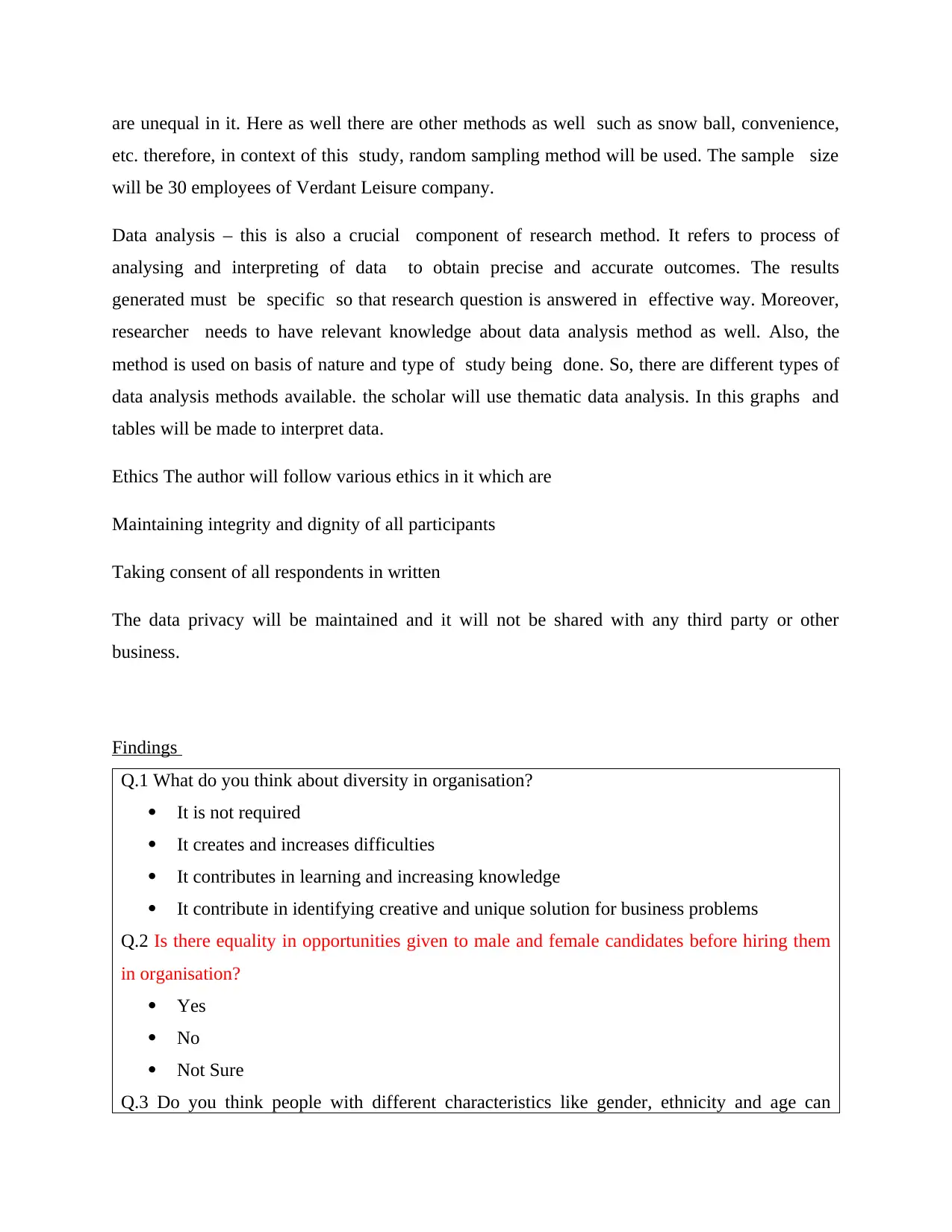
are unequal in it. Here as well there are other methods as well such as snow ball, convenience,
etc. therefore, in context of this study, random sampling method will be used. The sample size
will be 30 employees of Verdant Leisure company.
Data analysis – this is also a crucial component of research method. It refers to process of
analysing and interpreting of data to obtain precise and accurate outcomes. The results
generated must be specific so that research question is answered in effective way. Moreover,
researcher needs to have relevant knowledge about data analysis method as well. Also, the
method is used on basis of nature and type of study being done. So, there are different types of
data analysis methods available. the scholar will use thematic data analysis. In this graphs and
tables will be made to interpret data.
Ethics The author will follow various ethics in it which are
Maintaining integrity and dignity of all participants
Taking consent of all respondents in written
The data privacy will be maintained and it will not be shared with any third party or other
business.
Findings
Q.1 What do you think about diversity in organisation?
It is not required
It creates and increases difficulties
It contributes in learning and increasing knowledge
It contribute in identifying creative and unique solution for business problems
Q.2 Is there equality in opportunities given to male and female candidates before hiring them
in organisation?
Yes
No
Not Sure
Q.3 Do you think people with different characteristics like gender, ethnicity and age can
etc. therefore, in context of this study, random sampling method will be used. The sample size
will be 30 employees of Verdant Leisure company.
Data analysis – this is also a crucial component of research method. It refers to process of
analysing and interpreting of data to obtain precise and accurate outcomes. The results
generated must be specific so that research question is answered in effective way. Moreover,
researcher needs to have relevant knowledge about data analysis method as well. Also, the
method is used on basis of nature and type of study being done. So, there are different types of
data analysis methods available. the scholar will use thematic data analysis. In this graphs and
tables will be made to interpret data.
Ethics The author will follow various ethics in it which are
Maintaining integrity and dignity of all participants
Taking consent of all respondents in written
The data privacy will be maintained and it will not be shared with any third party or other
business.
Findings
Q.1 What do you think about diversity in organisation?
It is not required
It creates and increases difficulties
It contributes in learning and increasing knowledge
It contribute in identifying creative and unique solution for business problems
Q.2 Is there equality in opportunities given to male and female candidates before hiring them
in organisation?
Yes
No
Not Sure
Q.3 Do you think people with different characteristics like gender, ethnicity and age can
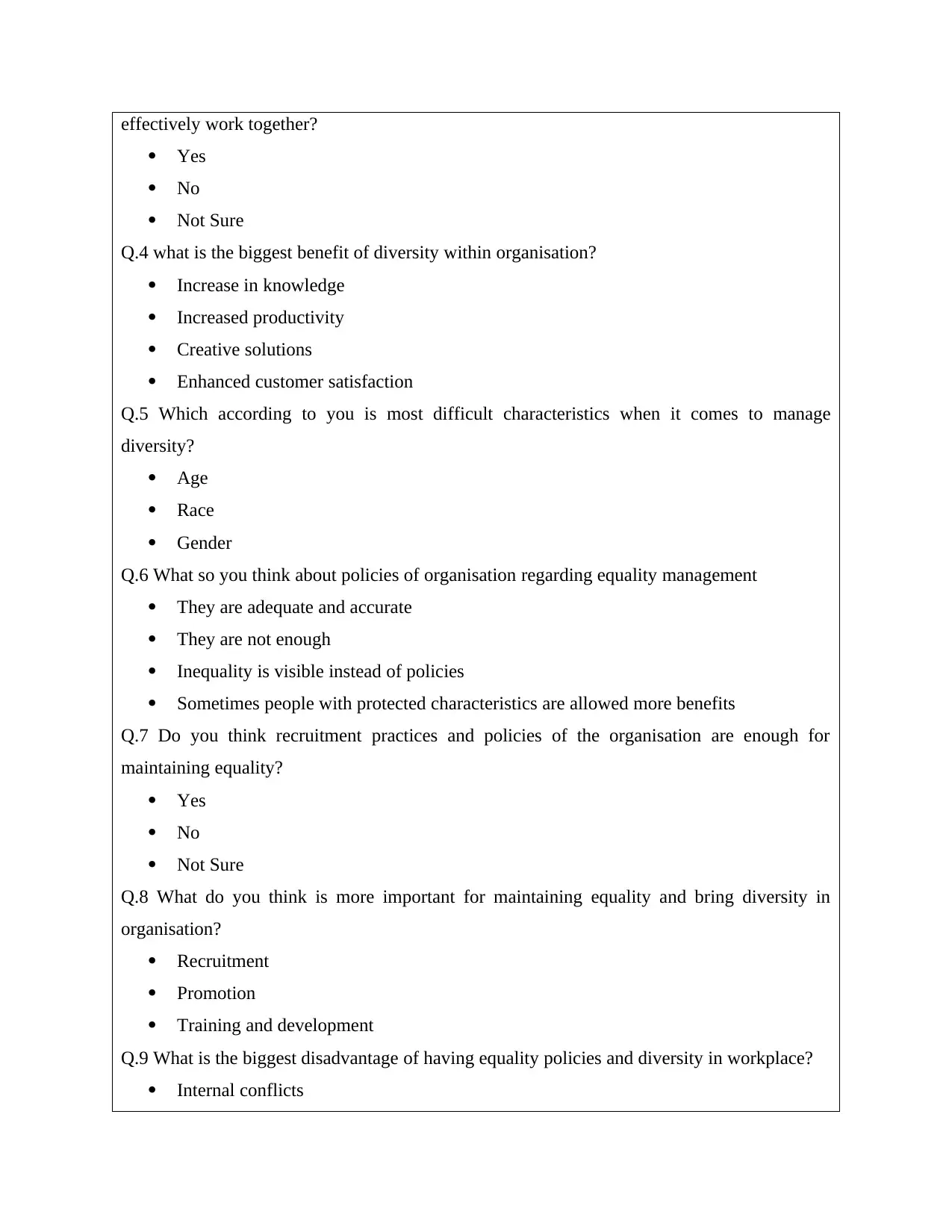
effectively work together?
Yes
No
Not Sure
Q.4 what is the biggest benefit of diversity within organisation?
Increase in knowledge
Increased productivity
Creative solutions
Enhanced customer satisfaction
Q.5 Which according to you is most difficult characteristics when it comes to manage
diversity?
Age
Race
Gender
Q.6 What so you think about policies of organisation regarding equality management
They are adequate and accurate
They are not enough
Inequality is visible instead of policies
Sometimes people with protected characteristics are allowed more benefits
Q.7 Do you think recruitment practices and policies of the organisation are enough for
maintaining equality?
Yes
No
Not Sure
Q.8 What do you think is more important for maintaining equality and bring diversity in
organisation?
Recruitment
Promotion
Training and development
Q.9 What is the biggest disadvantage of having equality policies and diversity in workplace?
Internal conflicts
Yes
No
Not Sure
Q.4 what is the biggest benefit of diversity within organisation?
Increase in knowledge
Increased productivity
Creative solutions
Enhanced customer satisfaction
Q.5 Which according to you is most difficult characteristics when it comes to manage
diversity?
Age
Race
Gender
Q.6 What so you think about policies of organisation regarding equality management
They are adequate and accurate
They are not enough
Inequality is visible instead of policies
Sometimes people with protected characteristics are allowed more benefits
Q.7 Do you think recruitment practices and policies of the organisation are enough for
maintaining equality?
Yes
No
Not Sure
Q.8 What do you think is more important for maintaining equality and bring diversity in
organisation?
Recruitment
Promotion
Training and development
Q.9 What is the biggest disadvantage of having equality policies and diversity in workplace?
Internal conflicts
⊘ This is a preview!⊘
Do you want full access?
Subscribe today to unlock all pages.

Trusted by 1+ million students worldwide
1 out of 29
Related Documents
Your All-in-One AI-Powered Toolkit for Academic Success.
+13062052269
info@desklib.com
Available 24*7 on WhatsApp / Email
![[object Object]](/_next/static/media/star-bottom.7253800d.svg)
Unlock your academic potential
Copyright © 2020–2025 A2Z Services. All Rights Reserved. Developed and managed by ZUCOL.





